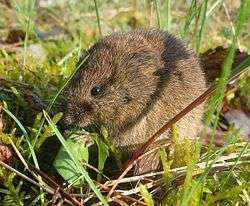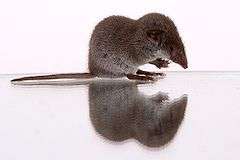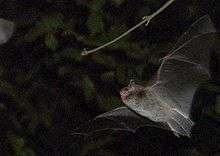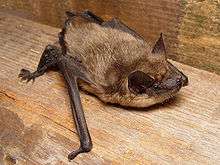List of mammals of Romania
-cropped.jpg)
This is a list of the mammal species recorded in Romania. There are 89 mammal species in Romania, of which 1 is critically endangered, 1 is endangered, 13 are vulnerable, and 4 are near-threatened.[1]
| Geography of Romania |
| Topography |
| Hydrography |
| Climate |
The following tags are used to highlight each species' conservation status as assessed by the IUCN:
| EX | Extinct | No reasonable doubt that the last individual has died. |
| EW | Extinct in the wild | Known only to survive in captivity or as a naturalized populations well outside its previous range. |
| CR | Critically endangered | The species is in imminent risk of extinction in the wild. |
| EN | Endangered | The species is facing an extremely high risk of extinction in the wild. |
| VU | Vulnerable | The species is facing a high risk of extinction in the wild. |
| NT | Near threatened | The species does not meet any of the criteria that would categorise it as risking extinction but it is likely to do so in the future. |
| LC | Least concern | There are no current identifiable risks to the species. |
| DD | Data deficient | There is inadequate information to make an assessment of the risks to this species. |
Some species were assessed using an earlier set of criteria. Species assessed using this system have the following instead of near threatened and least concern categories:
| LR/cd | Lower risk/conservation dependent | Species which were the focus of conservation programmes and may have moved into a higher risk category if that programme was discontinued. |
| LR/nt | Lower risk/near threatened | Species which are close to being classified as vulnerable but are not the subject of conservation programmes. |
| LR/lc | Lower risk/least concern | Species for which there are no identifiable risks. |
Subclass: Theria
Infraclass: Eutheria
Order: Rodentia (rodents)


Rodents make up the largest order of mammals, with over 40 percent of mammalian species. They have two incisors in the upper and lower jaw which grow continually and must be keep short by gnawing. Most rodents are small though the capybara can weigh up to 45 kg (100 lb).
- Suborder: Sciurognathi
- Family: Sciuridae (squirrels)
- Subfamily: Sciurinae
- Tribe: Sciurini
- Genus: Sciurus
- Red squirrel Sciurus vulgaris NT
- Genus: Sciurus
- Tribe: Sciurini
- Subfamily: Xerinae
- Tribe: Marmotini
- Genus: Marmota
- Alpine marmot Marmota marmota LR/lc
- Genus: Spermophilus
- European ground squirrel Spermophilus citellus VU
- Speckled ground squirrel Spermophilus suslicus VU
- Genus: Marmota
- Tribe: Marmotini
- Subfamily: Sciurinae
- Family: Gliridae (dormice)
- Subfamily: Leithiinae
- Genus: Dryomys
- Forest dormouse Dryomys nitedula LR/nt
- Genus: Eliomys
- Garden dormouse Eliomys quercinus VU
- Genus: Muscardinus
- Hazel dormouse Muscardinus avellanarius LR/nt
- Genus: Dryomys
- Subfamily: Glirinae
- Genus: Glis
- Edible dormouse Glis glis LR/nt
- Genus: Glis
- Subfamily: Leithiinae
- Family: Dipodidae (jerboas)
- Subfamily: Sicistinae
- Genus: Sicista
- Northern birch mouse Sicista betulina LR/nt
- Southern birch mouse Sicista subtilis LR/nt
- Genus: Sicista
- Subfamily: Sicistinae
- Family: Spalacidae
- Subfamily: Spalacinae
- Genus: Spalax
- Bukovin mole rat Spalax graecus VU
- Genus: Nannospalax
- Lesser mole rat Nannospalax leucodon VU
- Genus: Spalax
- Subfamily: Spalacinae
- Family: Cricetidae
- Subfamily: Cricetinae
- Genus: Cricetulus
- Gray dwarf hamster Cricetulus migratorius LR/nt
- Genus: Cricetus
- European hamster Cricetus cricetus LR/lc
- Genus: Mesocricetus
- Romanian hamster Mesocricetus newtoni VU
- Genus: Cricetulus
- Subfamily: Arvicolinae
- Genus: Arvicola
- Water vole Arvicola terrestris LR/lc
- Genus: Chionomys
- Snow vole Chionomys nivalis LR/nt
- Genus: Clethrionomys
- Bank vole Clethrionomys glareolus LR/lc
- Genus: Microtus
- Field vole Microtus agrestis LR/lc
- Common vole Microtus arvalis LR/lc
- Southern vole Microtus rossiaemeridionalis LR/lc
- European pine vole Microtus subterraneus LR/lc
- Tatra vole Microtus tatricus LR/nt
- Genus: Arvicola
- Subfamily: Cricetinae
- Family: Muridae (mice, rats, voles, gerbils, hamsters, etc.)
- Subfamily: Murinae
- Genus: Apodemus
- Striped field mouse Apodemus agrarius LR/lc
- Yellow-necked mouse Apodemus flavicollis LR/lc
- Wood mouse Apodemus sylvaticus LC
- Ural field mouse Apodemus uralensis LR/lc
- Genus: Micromys
- Harvest mouse Micromys minutus LR/nt
- Genus: Mus
- Steppe mouse Mus spicilegus LR/nt
- Genus: Apodemus
- Subfamily: Murinae
- Family: Sciuridae (squirrels)
Order: Lagomorpha (lagomorphs)
.jpg)
The lagomorphs comprise two families, Leporidae (hares and rabbits), and Ochotonidae (pikas). Though they can resemble rodents, and were classified as a superfamily in that order until the early twentieth century, they have since been considered a separate order. They differ from rodents in a number of physical characteristics, such as having four incisors in the upper jaw rather than two.
- Family: Leporidae (rabbits, hares)
- Genus: Oryctolagus
- European rabbit Oryctolagus cuniculus LR/lc
- Genus: Lepus
- European hare Lepus europaeus LR/lc
- Genus: Oryctolagus
Order: Erinaceomorpha (hedgehogs and gymnures)
The order Erinaceomorpha contains a single family, Erinaceidae, which comprise the hedgehogs and gymnures. The hedgehogs are easily recognised by their spines while gymnures look more like large rats.
- Family: Erinaceidae (hedgehogs)
- Subfamily: Erinaceinae
- Genus: Erinaceus
- Northern white-breasted hedgehog Erinaceus roumanicus LR/lc
- Genus: Erinaceus
- Subfamily: Erinaceinae
Order: Soricomorpha (shrews, moles, and solenodons)



The "shrew-forms" are insectivorous mammals. The shrews and solenodons closely resemble mice while the moles are stout-bodied burrowers.
- Family: Soricidae (shrews)
- Subfamily: Crocidurinae
- Genus: Crocidura
- Bicolored shrew Crocidura leucodon LR/lc
- Greater white-toothed shrew Crocidura russula LC
- Lesser white-toothed shrew Crocidura suaveolens LR/lc
- Genus: Crocidura
- Subfamily: Soricinae
- Tribe: Nectogalini
- Genus: Neomys
- Southern water shrew Neomys anomalus LR/lc
- Eurasian water shrew Neomys fodiens LR/lc
- Genus: Neomys
- Tribe: Soricini
- Genus: Sorex
- Alpine shrew Sorex alpinus LR/lc
- Common shrew Sorex araneus LR/lc
- Eurasian pygmy shrew Sorex minutus LR/lc
- Genus: Sorex
- Tribe: Nectogalini
- Subfamily: Crocidurinae
- Family: Talpidae (moles)
- Subfamily: Talpinae
- Tribe: Talpini
- Genus: Talpa
- European mole Talpa europaea LR/lc
- Genus: Talpa
- Tribe: Talpini
- Subfamily: Talpinae
Order: Chiroptera (bats)




The bats' most distinguishing feature is that their forelimbs are developed as wings, making them the only mammals in the world naturally capable of flight. Bat species account for about 20% of all mammals.
- Family: Vespertilionidae
- Subfamily: Myotinae
- Genus: Myotis
- Bechstein's bat Myotis bechsteini VU
- Lesser mouse-eared bat Myotis blythii LR/lc
- Brandt's bat Myotis brandti LR/lc
- Long-fingered bat Myotis capaccinii VU
- Daubenton's bat Myotis daubentonii LR/lc
- Geoffroy's bat Myotis emarginatus VU
- Greater mouse-eared bat Myotis myotis LR/nt
- Natterer's bat Myotis nattereri LR/lc
- Genus: Myotis
- Subfamily: Vespertilioninae
- Genus: Barbastella
- Barbastelle Barbastella barbastellus VU
- Genus: Eptesicus
- Northern bat Eptesicus nilssoni LR/lc
- Serotine bat Eptesicus serotinus LR/lc
- Genus: Nyctalus
- Greater noctule bat Nyctalus lasiopterus LR/nt
- Lesser noctule Nyctalus leisleri LR/nt
- Common noctule Nyctalus noctula LR/lc
- Genus: Pipistrellus
- Nathusius' pipistrelle Pipistrellus nathusii LR/lc
- Common pipistrelle Pipistrellus pipistrellus LC
- Genus: Plecotus
- Brown long-eared bat Plecotus auritus LR/lc
- Grey long-eared bat Plecotus austriacus LR/lc
- Genus: Barbastella
- Subfamily: Miniopterinae
- Genus: Miniopterus
- Schreibers' long-fingered bat Miniopterus schreibersii LC
- Genus: Miniopterus
- Subfamily: Myotinae
- Family: Rhinolophidae
- Subfamily: Rhinolophinae
- Genus: Rhinolophus
- Blasius's horseshoe bat Rhinolophus blasii NT
- Mediterranean horseshoe bat Rhinolophus euryale VU
- Greater horseshoe bat Rhinolophus ferrumequinum LR/nt
- Lesser horseshoe bat Rhinolophus hipposideros LC
- Mehely's horseshoe bat Rhinolophus mehelyi VU
- Genus: Rhinolophus
- Subfamily: Rhinolophinae
Order: Cetacea (whales)

The order Cetacea includes whales, dolphins and porpoises. They are the mammals most fully adapted to aquatic life with a spindle-shaped nearly hairless body, protected by a thick layer of blubber, and forelimbs and tail modified to provide propulsion underwater.
- Suborder: Odontoceti
- Superfamily: Platanistoidea
- Family: Phocoenidae
- Genus: Phocoena
- Harbour porpoise Phocoena phocoena VU
- Genus: Phocoena
- Family: Delphinidae (marine dolphins)
- Genus: Tursiops
- Bottlenose dolphin Tursiops truncatus DD
- Genus: Delphinus
- Common dolphin Delphinus delphis LR/lc
- Genus: Tursiops
- Family: Phocoenidae
- Superfamily: Platanistoidea
Order: Carnivora (carnivorans)
.jpg)

There are over 260 species of carnivorans, the majority of which feed primarily on meat. They have a characteristic skull shape and dentition.
- Suborder: Feliformia
- Suborder: Caniformia
- Family: Canidae (dogs, foxes)
- Genus: Vulpes
- Red fox Vulpes vulpes LC
- Genus: Canis
- Gray wolf Canis lupus LC
- Golden jackal Canis aureus LC
- Genus: Nyctereutes
- Raccoon dog Nyctereutes procyonoides LC
- Genus: Vulpes
- Family: Ursidae (bears)
- Genus: Ursus
- Brown bear Ursus arctos LR/lc
- Genus: Ursus
- Family: Mustelidae (mustelids)
- Genus: Mustela
- Stoat Mustela erminea LR/lc
- Steppe polecat Mustela eversmannii LR/lc
- European mink Mustela lutreola EN
- Least weasel Mustela nivalis LR/lc
- European polecat Mustela putorius LR/lc
- Genus: Vormela
- Marbled polecat Vormela peregusna LR/lc
- Genus: Martes
- Beech marten Martes foina LR/lc
- Pine marten Martes martes LR/lc
- Genus: Meles
- Eurasian badger Meles meles LR/lc
- Genus: Lutra
- European otter Lutra lutra NT
- Genus: Mustela
- Family: Phocidae (earless seals)
- Genus: Monachus
- Mediterranean monk seal Monachus monachus CR
- Genus: Monachus
- Family: Canidae (dogs, foxes)
Order: Artiodactyla (even-toed ungulates)
The even-toed ungulates are ungulates whose weight is borne about equally by the third and fourth toes, rather than mostly or entirely by the third as in perissodactyls. There are about 220 artiodactyl species, including many that are of great economic importance to humans.
- Family: Suidae (pigs)
- Family: Cervidae (deer)
- Subfamily: Cervinae
- Genus: Cervus
- Red deer Cervus elaphus LR/lc
- Genus: Dama
- Fallow deer Dama dama
- Genus: Cervus
- Subfamily: Capreolinae
- Subfamily: Cervinae
- Family: Bovidae (cattle, antelope, sheep, goats)
See also
- List of chordate orders
- List of regional mammals lists
- List of prehistoric mammals
- Mammal classification
- New mammal species
Notes
- ↑ This list is derived from the IUCN Red List which lists species of mammals and includes those mammals that have recently been classified as extinct (since 1500 AD). The taxonomy and naming of the individual species is based on those used in existing Wikipedia articles as of 21 May 2007 and supplemented by the common names and taxonomy from the IUCN, Smithsonian Institution, or University of Michigan where no Wikipedia article was available.
References
- "The IUCN Red List of Threatened Species: Mammals of Romania". IUCN. 2001. Retrieved 22 May 2007.
- "Mammal Species of the World". Smithsonian National Museum of Natural History. 2005. Archived from the original on 27 April 2007. Retrieved 22 May 2007.
- "Animal Diversity Web". University of Michigan Museum of Zoology. 1995–2006. Retrieved 22 May 2007.